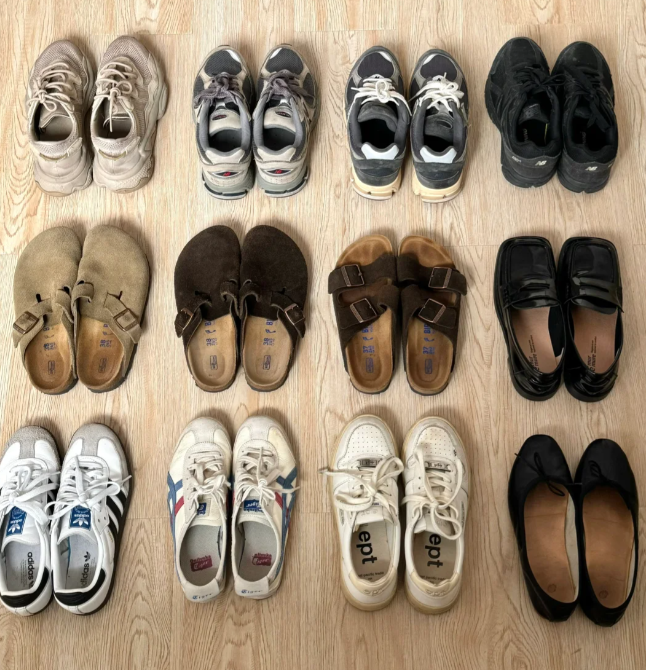How to choose shoes?
Reading times:474 Update time:2024-07-12
How to choose a pair of suitable shoes, healthy and comfortable?
1, the length of the shoe is 1cm longer than the foot, or the width of 1 finger.
Put the shoes flat on the ground, the heel of the foot on the heel of the shoe, the front of the toe, about 1cm width from the front of the shoe. Or with the shoe on, there is room in the heel to accommodate 1 finger. Neither too short nor too long.
2. The toe of the shoe retains 0.5 - 1.0cm of space for movement.
After putting on the shoes, the toes can be bent freely. Try to do the action of grabbing the toes, the upper of the shoe is not obviously topped up, so that the height is roughly appropriate.
3. The front 1/3 of the shoe can be bent.
The first 1/3 of the shoe can be bent, about 60 degrees, while the back 2/3 is relatively hard to play an effective support role. When choosing shoes, press the heel with your hand and be able to make the front 1/3 bend, so that the shoes can be chosen.
4, the front half of the shoe should be sturdy to avoid swaying from side to side, which is easy to walk unsteadily.
5, the sole of the shoe is slightly concave.
The sole of the shoe is slightly concave to reserve a certain space for the arch of the foot, and the heel and toe have a drop of about 6mm, which can play a better biomechanical role. The sole of the shoe should be soft and able to fit flexibly with the sole of the foot, especially with the arch of the foot when walking, to provide effective support. The sole should not be too soft to have a supportive effect. In addition to this, the sole should not be too small, too thin or too narrow to be prone to sprains.
The material of the sole is generally made of relatively hard rubber with a certain grain, which plays an effective anti-slip role. If the grain of the sole has been smoothed, it means that the service life of the shoes is over and new shoes need to be replaced in time.
6, heel guard has a certain hardness.
The heel guard is the place that wraps around the heel of the foot for a week, and it should have a certain degree of hardness to limit excessive and random activities. Squeeze hard with the index finger and thumb, still have a certain hardness, before you can choose. Shoes that are too soft do not provide effective protection. The choice of heel protection that is too soft is wrong.
7, the thickness of the heel is 1--2cm.
The thickness of the heel is 1 - 2cm, the highest not more than 5cm. less than 1cm, can not play an effective buffer role, only a small amount of indoor activities, is not suitable for long-distance walking, also not suitable for outdoor activities. If it is too high, refer to the adverse effects of high heels.
Heel can effectively enhance the stability of the movement, to avoid sports injuries, very critical! A good heel should be slightly flexible and on the hard side, but not too hard, so that it can effectively play a shock-absorbing cushioning effect.
Every step of walking, the foot will produce about 0.7 - 1.5 times the reaction force of gravity, these buffer forces will act on the lower limbs of the human body, if the heel is too hard, can not effectively play the role of buffer, shock absorption; too soft, but also does not have the role of protection, it should be a little elastic, the texture is hard. If there are patients with plantar fasciitis, you can choose shoes with air cushion; if there are patients with bone fracture, you should choose shoes with hard soles, and must not have air cushion.
8, the upper should be soft, so that it is comfortable to wear.
9, the shoes have good ventilation.
When exercising, especially in hot summer, good ventilation of shoes can avoid high foot temperature.
10, the workmanship of shoes should be good.
For example: when buying shoes, you can put the shoes flat on the table or on the ground, if the left and right shaking, it means that the shoes have problems with the workmanship.
12, the weight of the shoes is appropriate.
General men's shoes not more than 285 grams, women's shoes not more than 230 grams, too heavy will produce excessive resistance to the foot, not conducive to long-term large-scale activities.
The above for you to simply list some of the purchase of shoes to pay attention to the main points, may not be comprehensive, you can adjust according to their own experience and the actual situation as appropriate.

